Rise of the Machines: The Inevitable Evolution of Medicine and Medical Laboratories Intertwining with Artificial Intelligence—A Narrative Review
Abstract
:1. Introduction
2. But What Exactly Is AI?
3. AI in Day-to-Day Life
4. AI in Medicine Today
5. AI in the Medical Laboratory
5.1. Test Selection
5.2. Predicting Test Results
5.3. Result Generation
5.4. Result Interpretation
5.5. Other Applications
6. Challenges and Pitfalls
7. AI Applied Incorrectly
8. Will AI Replace Us?—No!
9. Conclusions
Funding
Conflicts of Interest
References
- Cadamuro, J.; Hillarp, A.; Unger, A.; von Meyer, A.; Bauca, J.M.; Plekhanova, O.; Linko-Parvinen, A.; Watine, J.; Leichtle, A.; Buchta, C.; et al. Presentation and formatting of laboratory results: A narrative review on behalf of the European Federation of Clinical Chemistry and Laboratory Medicine (EFLM) Working Group “postanalytical phase” (WG-POST). Crit. Rev. Clin. Lab. Sci. 2021, 1–41. [Google Scholar] [CrossRef]
- Bawden, D.; Robinson, L. The dark side of information: Overload, anxiety and other paradoxes and pathologies. J. Inf. Sci. 2008, 35, 180–191. [Google Scholar] [CrossRef]
- Brown, P.J.; Marquard, J.L.; Amster, B.; Romoser, M.; Friderici, J.; Goff, S.; Fisher, D. What Do Physicians Read (and Ignore) in Electronic Progress Notes? Appl. Clin. Inform. 2014, 5, 430–444. [Google Scholar] [PubMed] [Green Version]
- Topol, E.J. High-performance medicine: The convergence of human and artificial intelligence. Nat. Med. 2019, 25, 44–56. [Google Scholar] [CrossRef]
- Association for the Advancement of Artificial Intelligence. Available online: https://www.aaai.org/ (accessed on 16 May 2021).
- Topol, E. Deep Medicine: How Artificial Intelligence Can Make Healthcare Human Again; Hachette Book Group: New York, NY, USA, 2019. [Google Scholar]
- Buchanan, B.G.; Shortliffe, E.H. Rule-Based Expert Systems—The MYCIN Experiments of the Stanford Heuristic Programming Project. In The Addison-Wesley Series in Artificial Intelligence; Addison-Wesley Publishing Company: Reading, MA, USA, 1984. [Google Scholar]
- What Is GPT-3 And Why Is It Revolutionizing Artificial Intelligence? Available online: https://www.forbes.com/sites/bernardmarr/2020/10/05/what-is-gpt-3-and-why-is-it-revolutionizing-artificial-intelligence/?sh=feb0f02481ad (accessed on 15 May 2021).
- PanGu-α: Large-scale autoregressive pretrained chinese language models with auto-parallel computation. arXiv 2021, arXiv:2104.12369.
- U.S. Department of Health and Human Services Food and Drug Administration. Guidance for Industry Part 11, Electronic Records; Electronic Signatures—Scope and Application; U.S. Department of Health and Human Services Food and Drug Administration: Silver Spring, MD, USA, 2002. [Google Scholar]
- Huber, L. Implementing 21 CFR Part 11 in Analytical Laboratories—Part 1: Overview and Requirements. BioPharm 1999, 12, 28–34. [Google Scholar]
- General Data Protection Regulation (GDPR). Available online: https://eur-lex.europa.eu/eli/reg/2016/679/oj (accessed on 17 May 2021).
- European Medical Devices Regulation (MDR). Available online: https://eur-lex.europa.eu/legal-content/DE/TXT/?uri=CELEX:02017R0745-20200424 (accessed on 17 May 2021).
- European In-Vitro-Diagnostica Regulation (IVDR). Available online: https://eur-lex.europa.eu/legal-content/DE/TXT/?uri=CELEX:02017R0746-20170505 (accessed on 17 May 2021).
- Liang, H.; Tsui, B.Y.; Ni, H.; Valentim, C.C.S.; Baxter, S.L.; Liu, G.; Cai, W.; Kermany, D.S.; Sun, X.; Chen, J.; et al. Evaluation and accurate diagnoses of pediatric diseases using artificial intelligence. Nat. Med. 2019, 25, 433–438. [Google Scholar] [CrossRef] [PubMed]
- The Qualcomm Tricorder XPRIZE. Available online: https://www.xprize.org/prizes/tricorder (accessed on 17 May 2021).
- FDA-Approved A.I.-Based Algorithms. Available online: https://medicalfuturist.com/fda-approved-ai-based-algorithms/ (accessed on 15 May 2021).
- Aggarwal, R.; Sounderajah, V.; Martin, G.; Ting, D.S.W.; Karthikesalingam, A.; King, D.; Ashrafian, H.; Darzi, A. Diagnostic accuracy of deep learning in medical imaging: A systematic review and meta-analysis. NPJ Digit. Med. 2021, 4, 65. [Google Scholar] [CrossRef]
- Annarumma, M.; Withey, S.J.; Bakewell, R.J.; Pesce, E.; Goh, V.; Montana, G. Automated Triaging of Adult Chest Radiographs with Deep Artificial Neural Networks. Radiology 2019, 291, 196–202. [Google Scholar] [CrossRef]
- vRad—Teleradiology Services and Telemedicine Company. Available online: www.vrad.com (accessed on 17 May 2021).
- Esteva, A.; Kuprel, B.; Novoa, R.A.; Ko, J.; Swetter, S.M.; Blau, H.M.; Thrun, S. Dermatologist-level classification of skin cancer with deep neural networks. Nature 2017, 542, 115–118. [Google Scholar] [CrossRef] [PubMed]
- Freeman, K.; Dinnes, J.; Chuchu, N.; Takwoingi, Y.; Bayliss, S.E.; Matin, R.N.; Jain, A.; Walter, F.M.; Williams, H.C.; Deeks, J.J. Algorithm based smartphone apps to assess risk of skin cancer in adults: Systematic review of diagnostic accuracy studies. BMJ 2020, 368, m127. [Google Scholar] [CrossRef] [PubMed] [Green Version]
- Ting, D.S.W.; Cheung, C.Y.; Lim, G.; Tan, G.S.W.; Quang, N.D.; Gan, A.; Hamzah, H.; Garcia-Franco, R.; San Yeo, I.Y.; Lee, S.Y.; et al. Development and Validation of a Deep Learning System for Diabetic Retinopathy and Related Eye Diseases Using Retinal Images From Multiethnic Populations with Diabetes. JAMA 2017, 318, 2211–2223. [Google Scholar] [CrossRef]
- De Fauw, J.; Ledsam, J.R.; Romera-Paredes, B.; Nikolov, S.; Tomasev, N.; Blackwell, S.; Askham, H.; Glorot, X.; O’Donoghue, B.; Visentin, D.; et al. Clinically applicable deep learning for diagnosis and referral in retinal disease. Nat. Med. 2018, 24, 1342–1350. [Google Scholar] [CrossRef]
- Islam, M.M.; Yang, H.C.; Poly, T.N.; Jian, W.S.; Jack Li, Y.C. Deep learning algorithms for detection of diabetic retinopathy in retinal fundus photographs: A systematic review and meta-analysis. Comput. Methods Programs Biomed. 2020, 191, 105320. [Google Scholar] [CrossRef] [PubMed]
- Holme, O.; Aabakken, L. Making Colonoscopy Smarter With Standardized Computer-Aided Diagnosis. Ann. Intern. Med. 2018, 169, 409–410. [Google Scholar] [CrossRef]
- Wu, C.C.; Hsu, W.D.; Islam, M.M.; Poly, T.N.; Yang, H.C.; Nguyen, P.A.; Wang, Y.C.; Li, Y.J. An artificial intelligence approach to early predict non-ST-elevation myocardial infarction patients with chest pain. Comput. Methods Programs Biomed. 2019, 173, 109–117. [Google Scholar] [CrossRef] [PubMed]
- Islam, M.; Yang, H.C.; Nguyen, P.A.; Wang, Y.H.; Poly, T.N.; Li, Y.J. Deep Learning Approach for the Development of a Novel Predictive Model for Prostate Cancer. Stud. Health Technol. Inform. 2020, 270, 1241–1242. [Google Scholar]
- Wang, D.; Khosla, A.; Gargeya, R.; Irshad, H.; Beck, A.H. Deep Learning for Identifying Metastatic Breast Cancer. arXiv 2016, arXiv:1606.05718. [Google Scholar]
- Chan, J.; Raju, S.C.; Topol, E. Towards a tricorder for diagnosing paediatric conditions. Lancet 2019, 394, 907. [Google Scholar] [CrossRef]
- Chan, J.; Raju, S.; Nandakumar, R.; Bly, R.; Gollakota, S. Detecting middle ear fluid using smartphones. Sci. Transl. Med. 2019, 11. [Google Scholar] [CrossRef] [PubMed]
- Porter, P.; Abeyratne, U.; Swarnkar, V.; Tan, J.; Ng, T.W.; Brisbane, J.M.; Speldewinde, D.; Choveaux, J.; Sharan, R.; Kosasih, K.; et al. A prospective multicentre study testing the diagnostic accuracy of an automated cough sound centred analytic system for the identification of common respiratory disorders in children. Respir Res. 2019, 20, 81. [Google Scholar] [CrossRef] [PubMed]
- De Greef, L.; Goel, M.; Seo, M.J.; Larson, E.C.; Stout, J.W.; Taylor, J.A.; Patel, S.N. BiliCam: Using Mobile Phones to Monitor Newborn Jaundice. Ubicomp’14. In Proceedings of the 2014 Acm International Joint Conference on Pervasive and Ubiquitous Computing, Seattle, WA, USA, 13–17 September 2014; pp. 331–342. [Google Scholar]
- Mannino, R.G.; Myers, D.R.; Tyburski, E.A.; Caruso, C.; Boudreaux, J.; Leong, T.; Clifford, G.D.; Lam, W.A. Smartphone app for non-invasive detection of anemia using only patient-sourced photos. Nat. Commun. 2018, 9, 4924. [Google Scholar] [CrossRef] [PubMed] [Green Version]
- Stanford Medicine Health Trends Report 2020—The Rise of the Data-Driven Physician. Available online: https://med.stanford.edu/content/dam/sm/school/documents/Health-Trends-Report/Stanford%20Medicine%20Health%20Trends%20Report%202020.pdf (accessed on 13 May 2021).
- Forbes—Apple Watch 4 Is Now an FDA Class. 2 Medical Device: Detects Falls, Irregular Heart Rhythm. Available online: https://www.forbes.com/sites/jeanbaptiste/2018/09/14/apple-watch-4-is-now-an-fda-class-2-medical-device-detects-falls-irregular-heart-rhythm/?sh=549024482071 (accessed on 30 May 2021).
- Cadamuro, J.; Gaksch, M.; Wiedemann, H.; Lippi, G.; von Meyer, A.; Pertersmann, A.; Auer, S.; Mrazek, C.; Kipman, U.; Felder, T.K.; et al. Are laboratory tests always needed? Frequency and causes of laboratory overuse in a hospital setting. Clin. Biochem. 2018, 54, 85–91. [Google Scholar] [CrossRef]
- Freedman, D. Towards better test utilization—Strategies to improve physician ordering and their impact on patient outcomes. JIFCC 2015, 26, 15–30. [Google Scholar]
- Gandhi, T.K.; Kachalia, A.; Thomas, E.J.; Puopolo, A.L.; Yoon, C.; Brennan, T.A.; Studdert, D.M. Missed and delayed diagnoses in the ambulatory setting: A study of closed malpractice claims. Ann. Intern. Med. 2006, 145, 488–496. [Google Scholar] [CrossRef] [PubMed]
- Schiff, G.D.; Hasan, O.; Kim, S.; Abrams, R.; Cosby, K.; Lambert, B.L.; Elstein, A.S.; Hasler, S.; Kabongo, M.L.; Krosnjar, N.; et al. Diagnostic error in medicine: Analysis of 583 physician-reported errors. Arch. Intern. Med. 2009, 169, 1881–1887. [Google Scholar] [CrossRef]
- Plebani, M. Towards a new paradigm in laboratory medicine: The five rights. Clin. Chem. Lab. Med. 2016, 54, 1881–1891. [Google Scholar] [CrossRef]
- Ronzio, L.; Cabitza, F.; Barbaro, A.; Banfi, G. Has the Flood Entered the Basement? A Systematic Literature Review about Machine Learning in Laboratory Medicine. Diagnostics 2021, 11, 372. [Google Scholar] [CrossRef]
- Islam, M.M.; Yang, H.C.; Poly, T.N.; Li, Y.J. Development of an Artificial Intelligence-Based Automated Recommendation System for Clinical Laboratory Tests: Retrospective Analysis of the National Health Insurance Database. JMIR Med. Inform. 2020, 8, e24163. [Google Scholar] [CrossRef]
- Islam, M.M.; Poly, T.N.; Yang, H.C.; Li, Y. Deep into Laboratory: An artificial Intelligence Approach to Recommend Laboratory Tests. Diagnostics 2021, 11, 990. [Google Scholar] [CrossRef]
- Cheng, L.; Prasad, N.; Engelhardt, B.E. An Optimal Policy for Patient Laboratory Tests in Intensive Care Units. In Proceedings of the Pacific Symposium on Biocomputing, Puako, HI, USA, 3–7 January 2019. [Google Scholar]
- Xu, S.; Hom, J.; Balasubramanian, S.; Schroeder, L.F.; Najafi, N.; Roy, S.; Chen, J.H. Prevalence and Predictability of Low-Yield Inpatient Laboratory Diagnostic Tests. JAMA Netw. Open 2019, 2, e1910967. [Google Scholar] [CrossRef] [Green Version]
- Luo, Y.; Szolovits, P.; Dighe, A.S.; Baron, J.M. Using Machine Learning to Predict Laboratory Test Results. Am. J. Clin. Pathol. 2016, 145, 778–788. [Google Scholar] [CrossRef] [PubMed] [Green Version]
- Lobo, B.; Abdel-Rahman, E.; Brown, D.; Dunn, L.; Bowman, B. A recurrent neural network approach to predicting hemoglobin trajectories in patients with End-Stage Renal Disease. Artif. Intell. Med. 2020, 104, 101823. [Google Scholar] [CrossRef]
- Burton, R.J.; Albur, M.; Eberl, M.; Cuff, S.M. Using artificial intelligence to reduce diagnostic workload without compromising detection of urinary tract infections. BMC Med. Inform. Decis. Mak. 2019, 19, 1–11. [Google Scholar] [CrossRef] [PubMed] [Green Version]
- Yasin, O.Z.; Attia, Z.; Dillon, J.J.; DeSimone, C.V.; Sapir, Y.; Dugan, J.; Somers, V.K.; Ackerman, M.J.; Asirvatham, S.J.; Scott, C.G.; et al. Noninvasive blood potassium measurement using signal-processed, single-lead ecg acquired from a handheld smartphone. J. Electrocardiol. 2017, 50, 620–625. [Google Scholar] [CrossRef] [Green Version]
- Yu, L.; Zhang, Q.; Bernstam, E.V.; Jiang, X. Predict or draw blood: An integrated method to reduce lab tests. J. Biomed. Inform. 2020, 104, 103394. [Google Scholar] [CrossRef]
- Dillon, J.J.; DeSimone, C.V.; Sapir, Y.; Somers, V.K.; Dugan, J.L.; Bruce, C.J.; Ackerman, M.J.; Asirvatham, S.J.; Striemer, B.L.; Bukartyk, J.; et al. Noninvasive potassium determination using a mathematically processed ECG: Proof of concept for a novel “blood-less, blood test”. J. Electrocardiol. 2015, 48, 12–18. [Google Scholar] [CrossRef] [Green Version]
- Borges Monteiroa, A.C.; Ianoa, Y.; Franca, R.P.; Arthur, R. Development of a laboratory medical algorithm for simultaneous detection and counting of erythrocytes and leukocytes in digital images of a blood smear. In Deep Learning Techniques for Biomedical and Health Informatics; Agarwal, B., Balas, V.E., Jain, L.C., Poonia, R.C., Manisha, Eds.; Elsevier Inc.: Amsterdam, The Netherlands, 2020; pp. 165–186. [Google Scholar]
- Cho, J.; Oh, K.J.; Jeon, B.C.; Lee, S.-G.; Kim, J.-H. Comparison of five automated urine sediment analyzers with manual microscopy for accurate identification of urine sediment. Clin. Chem. Lab. Med. 2019, 57, 1744–1753. [Google Scholar] [CrossRef] [PubMed]
- SightDx—Olo—CBC Analyzer. Available online: https://www.sightdx.com/product (accessed on 15 May 2021).
- Altinier, S.; Sarti, L.; Varagnolo, M.; Zaninotto, M.; Maggini, M.; Plebani, M. An expert system for the classification of serum protein electrophoresis patterns. Clin. Chem. Lab. Med. 2008, 46, 1458–1463. [Google Scholar] [CrossRef] [PubMed]
- Healthy.io. Available online: https://healthy.io/ (accessed on 10 May 2021).
- Gunčar, G.; Kukar, M.; Notar, M.; Brvar, M.; Černelč, P.; Notar, M.; Notar, M. Application of machine learning for hematological diagnosis. Sci. Rep. 2018, 8, 1–12. [Google Scholar] [CrossRef] [PubMed]
- Wickramaratne, S.D.; Shaad Mahmud, M.D. Bi-Directional Gated Recurrent Unit Based Ensemble Model for the Early Detection of Sepsis. Annu. Int. Conf. IEEE Eng. Med. Biol. Soc. 2020, 2020, 70–73. [Google Scholar] [PubMed]
- De Anda-Jauregui, G.; Hernandez-Lemus, E. Computational Oncology in the Multi-Omics Era: State of the Art. Front. Oncol. 2020, 10, 423. [Google Scholar] [CrossRef] [PubMed]
- Nicora, G.; Vitali, F.; Dagliati, A.; Geifman, N.; Bellazzi, R. Integrated Multi-Omics Analyses in Oncology: A Review of Machine Learning Methods and Tools. Front. Oncol. 2020, 10, 1030. [Google Scholar] [CrossRef] [PubMed]
- Mayampurath, A.; Sanchez-Pinto, L.N.; Carey, K.A.; Venable, L.-R.; Churpek, M. Combining patient visual timelines with deep learning to predict mortality. PLoS ONE 2019, 14, e0220640. [Google Scholar] [CrossRef] [Green Version]
- Naugler, C.; Church, D.L. Automation and artificial intelligence in the clinical laboratory. Crit. Rev. Clin. Lab. Sci. 2019, 56, 98–110. [Google Scholar] [CrossRef]
- Mitani, T.; Doi, S.; Yokota, S.; Imai, T.; Ohe, K. Highly accurate and explainable detection of specimen mix-up using a machine learning model. Clin. Chem. Lab. Med. 2020, 58, 375–383. [Google Scholar] [CrossRef] [Green Version]
- How IBM Watson Overpromised and Underdelivered on AI Health Care. Available online: https://spectrum.ieee.org/biomedical/diagnostics/how-ibm-watson-overpromised-and-underdelivered-on-ai-health-care (accessed on 30 June 2021).
- Evans, J.; Rzhetsky, A. Philosophy of science. Machine science. Science 2010, 329, 399–400. [Google Scholar]
- The Guardian—The Cambridge Analytica Scandal Changed the World—But It Didn’t Change Facebook. Available online: https://www.theguardian.com/technology/2019/mar/17/the-cambridge-analytica-scandal-changed-the-world-but-it-didnt-change-facebook (accessed on 30 June 2021).
- Powerful Video Warns of the Danger of Autonomous ‘Slaughterbot’ Drone Swarms. Available online: https://globalnews.ca/news/3880186/powerful-video-warns-of-the-danger-of-autonomous-slaughterbot-drone-swarms/ (accessed on 30 June 2021).
- Semigran, H.L.; Linder, J.A.; Gidengil, C.; Mehrotra, A. Evaluation of symptom checkers for self diagnosis and triage: Audit study. BMJ 2015, 351, h3480. [Google Scholar] [CrossRef] [Green Version]
- Chambers, D.; Cantrell, A.J.; Johnson, M.; Preston, L.; Baxter, S.K.; Booth, A.; Turner, J. Digital and online symptom checkers and health assessment/triage services for urgent health problems: Systematic review. BMJ Open 2019, 9, e027743. [Google Scholar] [CrossRef] [Green Version]
- Abbas, R.; Richardson, I.; Carroll, N. The Algorithm Will See You Now: Exploring the Implications of Algorithmic Decision-making in Connected Health. In Proceedings of the 13th International Joint Conference on Biomedical Engineering Systems and Technologies, Valletta, Malta, 24–26 February 2020; pp. 758–765. [Google Scholar]
- Reddit-Discussion with Gary Kasparov. Available online: https://www.reddit.com/r/IAmA/comments/nfegqm/hello_reddit_im_garry_kasparov_former_world_chess/gylcet6/?utm_medium=android_app&utm_source=share&context=3 (accessed on 18 May 2021).
- Find Out If Your Job Will Be Automated. Available online: https://www.bloomberg.com/graphics/2017-job-risk/ (accessed on 23 March 2020).
- Sinsky, C.; Colligan, L.; Li, L.; Prgomet, M.; Reynolds, S.; Goeders, L.; Westbrook, J.; Tutty, M.; Blike, G. Allocation of Physician Time in Ambulatory Practice: A Time and Motion Study in 4 Specialties. Ann. Intern. Med. 2016, 165, 753–760. [Google Scholar] [CrossRef]
- Cervellin, G.; Borghi, L.; Lippi, G. Do clinicians decide relying primarily on Bayesians principles or on Gestalt perception? Some pearls and pitfalls of Gestalt perception in medicine. Intern. Emerg. Med. 2014, 9, 513–519. [Google Scholar] [CrossRef] [PubMed]
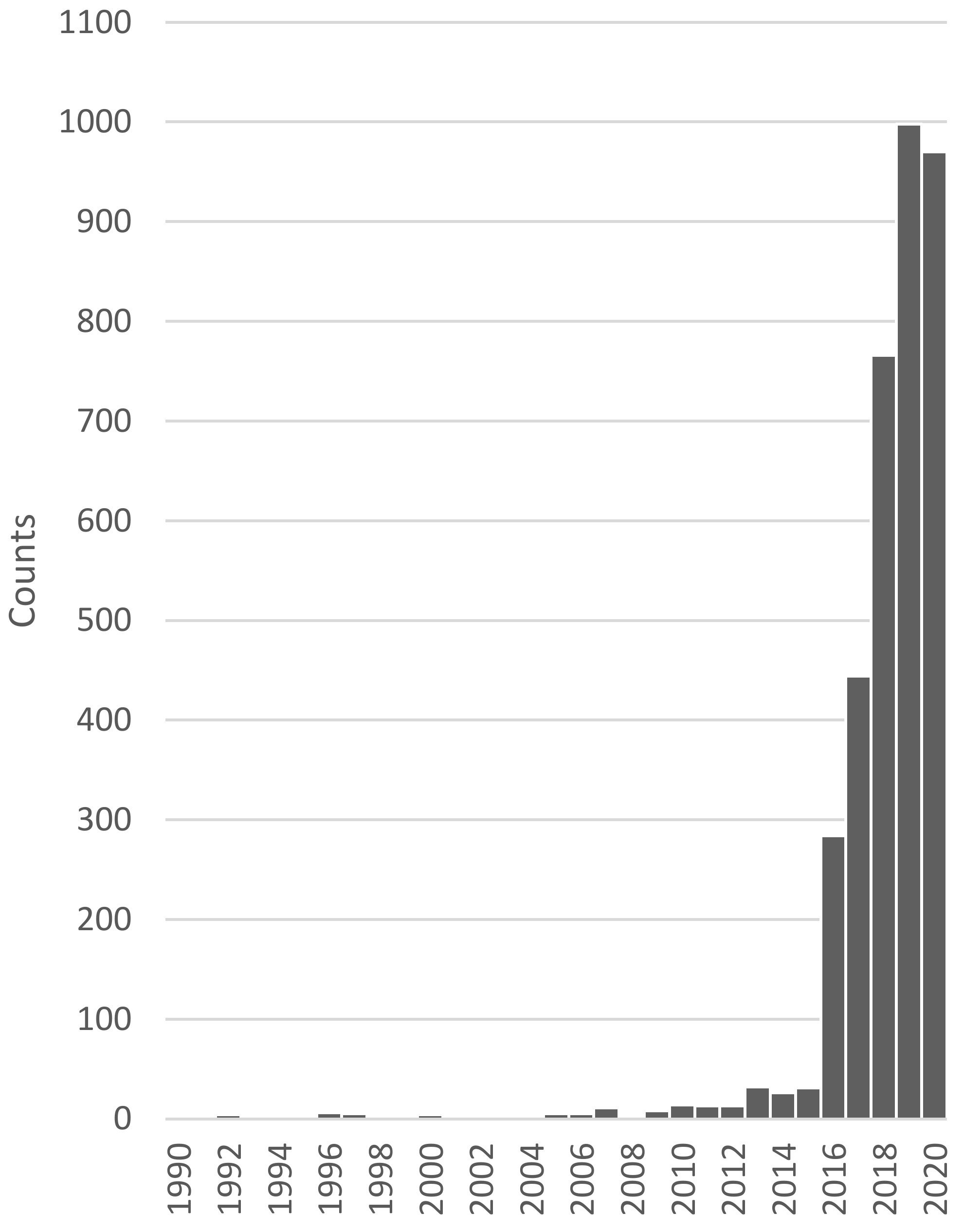
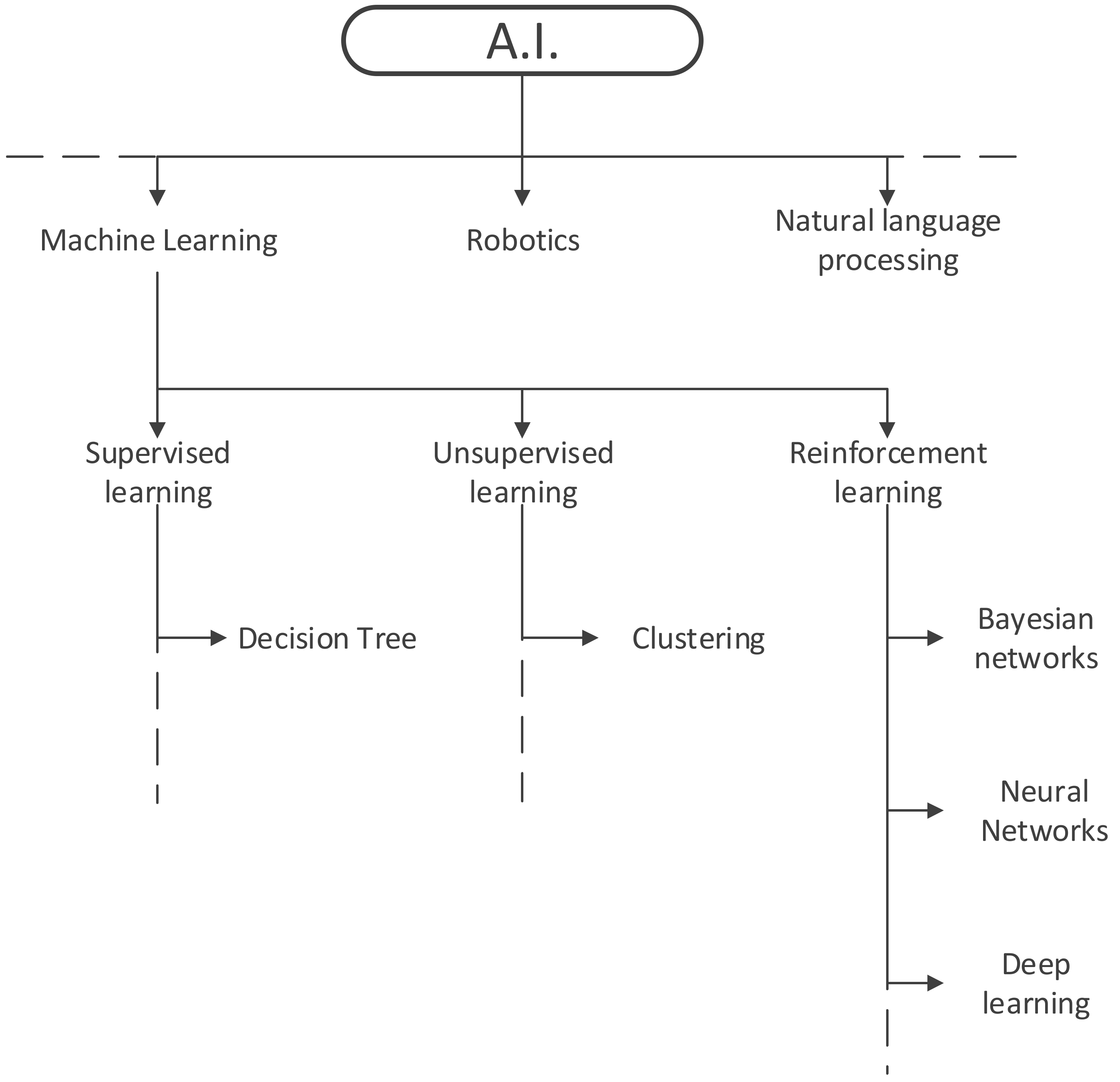
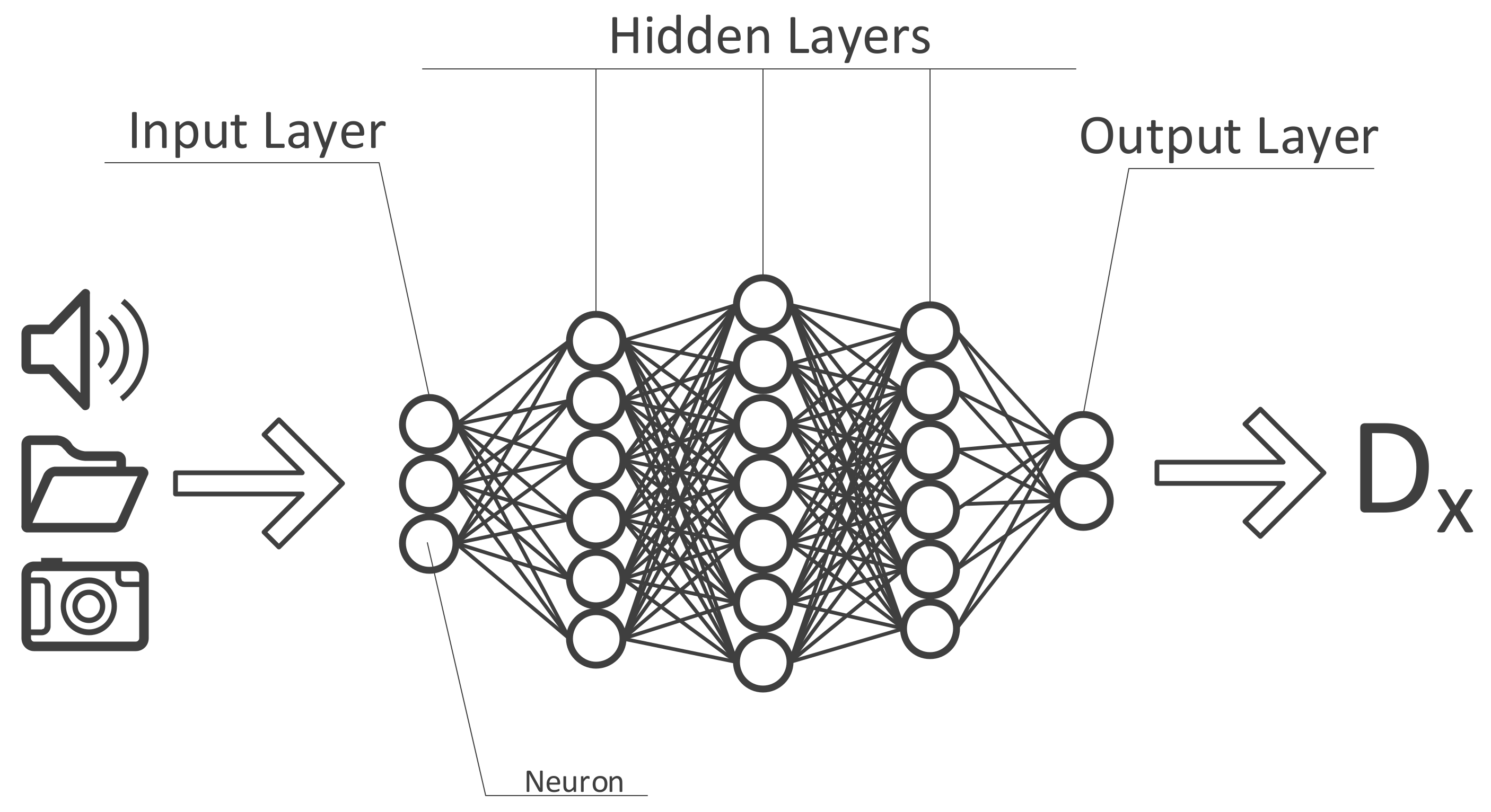
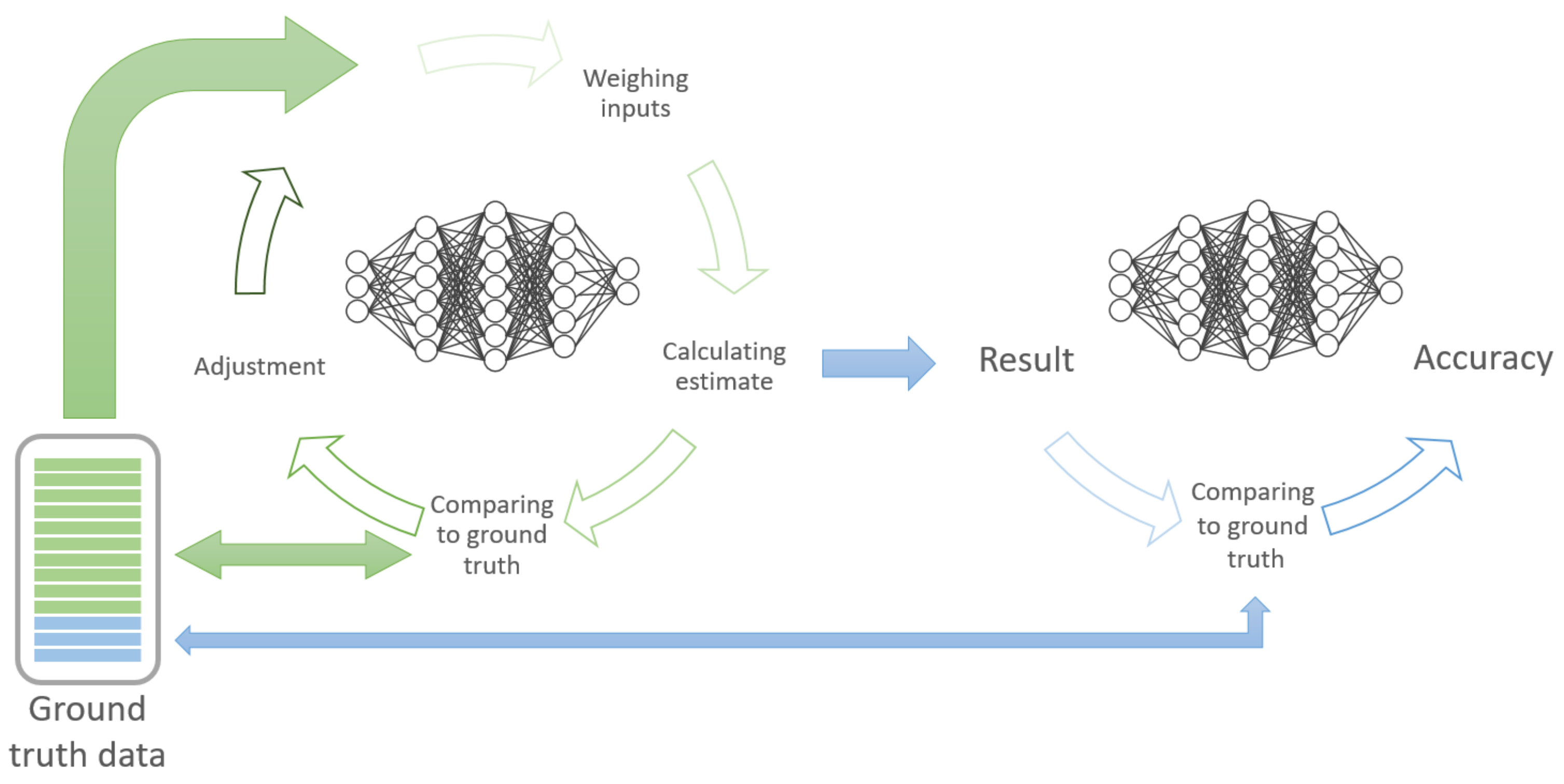
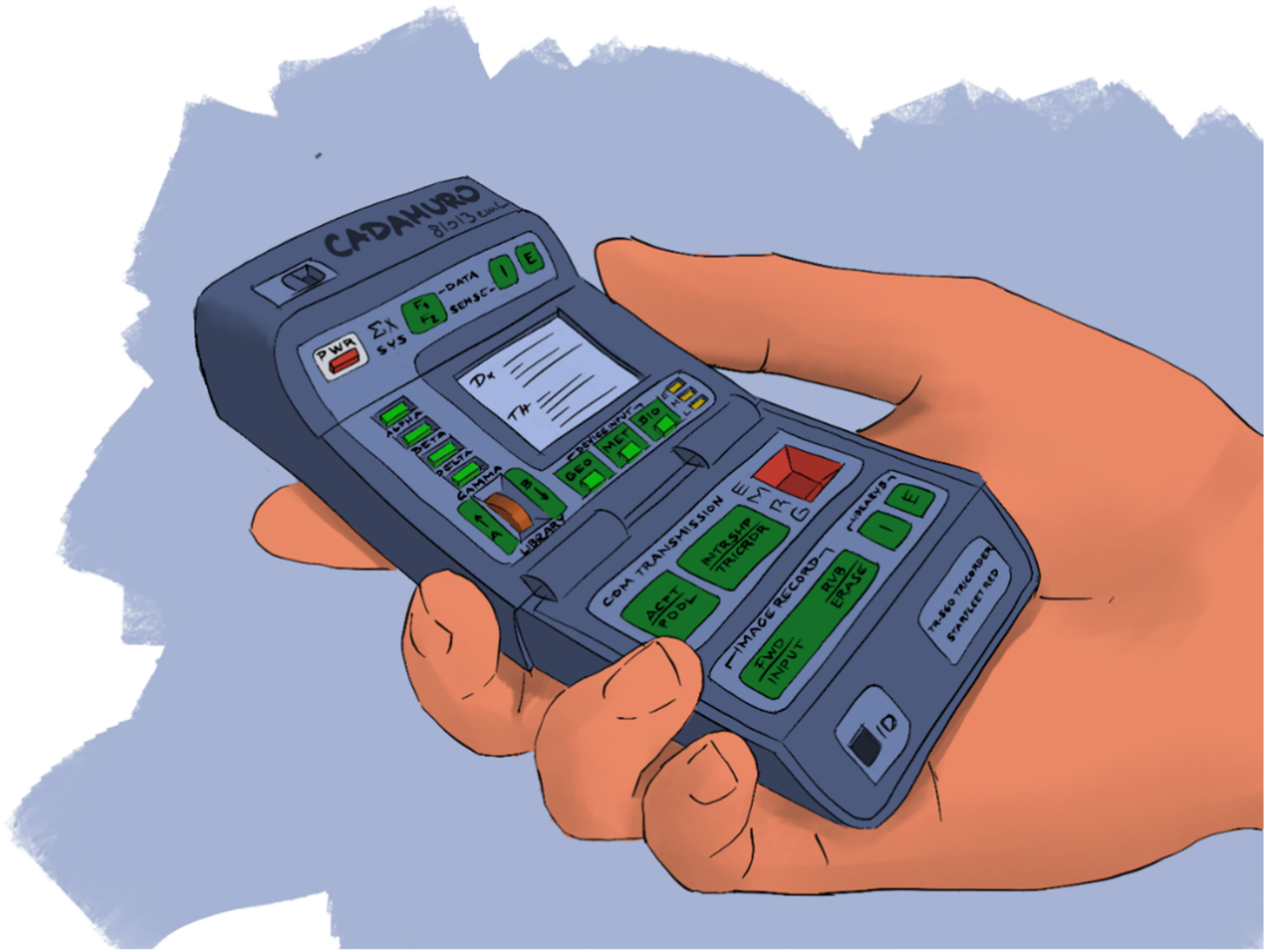
Publisher’s Note: MDPI stays neutral with regard to jurisdictional claims in published maps and institutional affiliations. |
© 2021 by the author. Licensee MDPI, Basel, Switzerland. This article is an open access article distributed under the terms and conditions of the Creative Commons Attribution (CC BY) license (https://creativecommons.org/licenses/by/4.0/).
Share and Cite
Cadamuro, J. Rise of the Machines: The Inevitable Evolution of Medicine and Medical Laboratories Intertwining with Artificial Intelligence—A Narrative Review. Diagnostics 2021, 11, 1399. https://doi.org/10.3390/diagnostics11081399
Cadamuro J. Rise of the Machines: The Inevitable Evolution of Medicine and Medical Laboratories Intertwining with Artificial Intelligence—A Narrative Review. Diagnostics. 2021; 11(8):1399. https://doi.org/10.3390/diagnostics11081399
Chicago/Turabian StyleCadamuro, Janne. 2021. "Rise of the Machines: The Inevitable Evolution of Medicine and Medical Laboratories Intertwining with Artificial Intelligence—A Narrative Review" Diagnostics 11, no. 8: 1399. https://doi.org/10.3390/diagnostics11081399
APA StyleCadamuro, J. (2021). Rise of the Machines: The Inevitable Evolution of Medicine and Medical Laboratories Intertwining with Artificial Intelligence—A Narrative Review. Diagnostics, 11(8), 1399. https://doi.org/10.3390/diagnostics11081399





